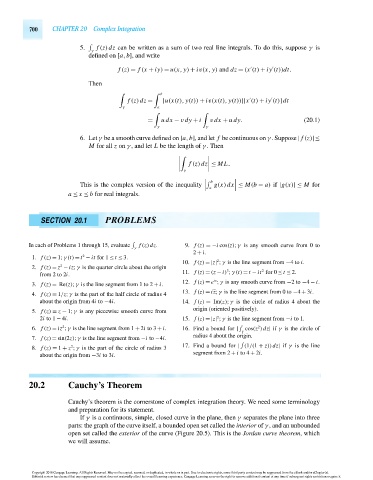Page 720 - Advanced_Engineering_Mathematics o'neil
P. 720
700 CHAPTER 20 Complex Integration
5. f (z)dz can be written as a sum of two real line integrals. To do this, suppose γ is
γ
defined on [a,b], and write
f (z) = f (x + iy) = u(x, y) + iv(x, y) and dz = (x (t) + iy (t))dt.
Then
b
f (z)dz = [u(x(t), y(t)) + iv(x(t), y(t))][x (t) + iy (t)]dt
γ a
= udx − v dy + i v dx + udy. (20.1)
γ γ
6. Let γ be a smooth curve defined on [a,b], and let f be continuous on γ . Suppose | f (z)|≤
M for all z on γ , and let L be the length of γ . Then
f (z)dz ≤ ML.
γ
b
g(x)dx ≤ M(b − a) if |g(x)|≤ M for
a
This is the complex version of the inequality
a ≤ x ≤ b for real integrals.
SECTION 20.1 PROBLEMS
In each of Problems 1 through 15, evaluate f (z)dz. 9. f (z) =−i cos(z);γ is any smooth curve from 0 to
γ
2 + i.
2
1. f (z) = 1;γ(t) = t − it for 1 ≤ t ≤ 3.
2
10. f (z) =|z| ;γ is the line segment from −4to i.
2. f (z) = z − iz;γ is the quarter circle about the origin 3 2
2
from2to2i. 11. f (z) = (z − i) ;γ(t) = t − it for 0 ≤ t ≤ 2.
iz
3. f (z) = Re(z);γ is the line segment from 1 to 2 + i. 12. f (z) = e ;γ is any smooth curve from −2to −4 − i.
4. f (z) = 1/z;γ is the part of the half circle of radius 4 13. f (z) = iz;γ is the line segment from 0 to −4 + 3i.
about the origin from 4i to −4i. 14. f (z) = Im(z);γ is the circle of radius 4 about the
5. f (z) = z − 1;γ is any piecewise smooth curve from origin (oriented positively).
2i to 1 − 4i. 15. f (z) =|z| ;γ is the line segment from −i to 1.
2
2
2
6. f (z) = iz ;γ is the line segment from 1 + 2i to 3 + i. 16. Find a bound for | cos(z )dz| if γ is the circle of
γ
radius 4 about the origin.
7. f (z) = sin(2z);γ is the line segment from −i to −4i.
2
8. f (z) = 1 + z ;γ is the part of the circle of radius 3 17. Find a bound for | (1/(1 + z))dz| if γ is the line
segment from 2 + i to 4 + 2i.
about the origin from −3i to 3i.
20.2 Cauchy’s Theorem
Cauchy’s theorem is the cornerstone of complex integration theory. We need some terminology
and preparation for its statement.
If γ is a continuous, simple, closed curve in the plane, then γ separates the plane into three
parts: the graph of the curve itself, a bounded open set called the interior of γ , and an unbounded
open set called the exterior of the curve (Figure 20.5). This is the Jordan curve theorem, which
we will assume.
Copyright 2010 Cengage Learning. All Rights Reserved. May not be copied, scanned, or duplicated, in whole or in part. Due to electronic rights, some third party content may be suppressed from the eBook and/or eChapter(s).
Editorial review has deemed that any suppressed content does not materially affect the overall learning experience. Cengage Learning reserves the right to remove additional content at any time if subsequent rights restrictions require it.
October 14, 2010 15:32 THM/NEIL Page-700 27410_20_ch20_p695-714

